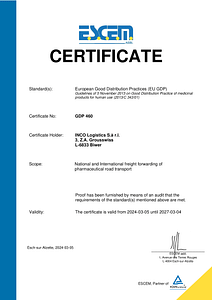Warehouse logistics refers to the area of logistics that deals with the planning, organization and execution of warehouse processes and warehouse activities. The aim of warehouse logistics is to ensure that goods are stored efficiently and that customers are optimally supplied by having the right goods available in the right place at the right time.
Warehouse logistics encompasses a variety of tasks and activities, including:
Warehouse planning: this involves strategic planning of warehouse capacity, locations, warehouse layout, and warehouse infrastructure to optimize warehouse operations.
Receiving: the acceptance of goods from suppliers or producers, checking for completeness and quality, and recording inventory levels in the warehouse.
Warehousing: The organization and management of inventory, including the placement and management of goods to ensure efficient storage.
Picking: The compilation of customer orders from stock in preparation for deliveries.
Packing and Shipping Preparation: The packing of goods for shipment to customers and the preparation of deliveries.
Inventory: The periodic taking of inventory to verify stock levels and identify discrepancies.
Warehouse Control and Management Systems: The use of warehouse management systems and technologies to efficiently manage warehouse operations, track the flow of goods, and optimize warehouse processes.
Optimizing warehouse costs: warehouse logistics aims to minimize warehouse costs by enabling optimal inventory management and movement.
Coordination with other logistics areas: Warehouse logistics is closely linked to other areas of logistics, such as transportation and distribution, to ensure a smooth flow of goods along the entire supply chain.
Efficient warehouse logistics is crucial to increasing companies’ competitiveness, enhancing customer satisfaction and reducing costs. It plays a crucial role in ensuring a smooth supply of goods and services and helps to optimize the supply chain as a whole.
How can warehouse logistics be optimized to reduce inventory costs?
Optimizing warehouse logistics to reduce warehousing costs requires careful planning, efficiency improvements and the application of best practices. Here are some steps and actions companies can take to optimize warehouse logistics and reduce inventory costs:
Inventory management: effective inventory management is critical to avoid overstocking and ensure that inventory levels always reflect current demand. Through accurate demand analysis and the use of inventory forecasting, inventory levels can be better controlled and reduced to the minimum necessary.
Warehouse layout and placement: A well-designed warehouse layout can improve efficiency in storing and retrieving goods. Placing the most frequently requested products near the goods issue (ABC analysis) and using shelving systems that facilitate access to goods help reduce labor times and costs.
Automation and technology: automating warehouse processes, such as using automated picking systems, conveyor technology and warehouse management systems, can increase efficiency and minimize human error. The use of technology can optimize warehouse logistics and reduce labor costs.
Supplier and procurement management: efficient collaboration with suppliers and optimized procurement can help shorten delivery times and implement just-in-time principles to reduce inventory levels.
Route optimization: Optimizing transportation and shipping routes can help shorten delivery times and reduce transportation costs.
Returns management: Well-organized returns management minimizes inventory and reduces the cost of processing returns.
Staff training and development: A well-trained workforce can make warehouse logistics more efficient and reduce errors. Continuous training enables employees to improve their skills and adapt to new technologies and processes.
Sustainability and environmental considerations: Adopting sustainable warehouse practices, such as energy-efficient lighting or reusable packaging, can lower operating costs and reduce environmental impact.
By taking a holistic view of warehouse logistics and implementing efficiency-enhancing measures, companies can reduce warehousing costs and optimize their warehouse logistics. Continuous monitoring and evaluation of warehouse processes makes it possible to identify weak points and make constant improvements.
How are steel products prepared and secured for transport?
Preparing and securing steel products for transportation is critical to prevent damage during shipping and ensure the safety of transportation workers and other road users. Here are some common practices for preparing and securing steel products for shipment:
Packaging: Steel products should be adequately packaged to protect them from outside elements such as moisture, dust and dirt. This may include the use of protective film, cardboard boxes, foam padding or special containers, depending on the type and size of the steel products.
Stability: the cargo must be arranged in such a way that it remains stable during transport. This means that steel products should be properly secured on pallets, in containers, or on loading platforms to prevent shifting or tipping over.
Lashing straps and tension straps: Lashing straps and tension straps are important tools for securing cargo. They are tightened around the steel products and the transport equipment (e.g. the truck trailer or container) to secure the load firmly.
Corner protection: For delicate steel products, it is advisable to use corner protection pads to protect the edges from damage and prevent lashing straps from chafing.
Use of disposable or reusable packaging: Disposable or reusable packaging can be used, depending on your needs. Reusable packaging is more environmentally friendly and can reduce transport costs in the long term.
Weight distribution: The load must be evenly distributed on the transport equipment to avoid excessive load on certain areas.
Labeling and documentation: the cargo should be properly labeled so that transport workers and recipients can easily identify the steel products. The necessary transportation documents should also be prepared and provided.
Regulatory compliance: It is important to follow applicable transportation regulations and safety guidelines to avoid accidents and legal violations.
Exact preparation and security measures may vary depending on the type and size of steel products as well as specific transportation conditions. Experienced logistics experts and freight forwarders can provide helpful advice in planning and executing a safe steel transport.
How can warehouse logistics help reduce delivery times and improve customer satisfaction?
Warehouse logistics can play a crucial role in shortening delivery times and improving customer satisfaction. With efficient and well-organized warehousing, companies can ship goods faster and better meet customer demands. Here are some ways warehouse logistics can help reduce delivery times and improve customer satisfaction:
Fast picking: Efficient picking is critical to assembling orders quickly and accurately. Using modern technology such as pick-by-light systems, pick-by-voice or automated picking systems can increase picking speed and minimize errors.
Storage close to location: placing top-selling products or frequently requested items close to the warehouse or in special quick-access areas can shorten pick time and reduce shipping time.
Real-time inventory: Using real-time inventory methods, such as barcode scanning or RFID technology, enables accurate and fast inventory control to avoid shortages and ensure high product availability.
Intelligent warehouse management systems: The use of advanced warehouse management systems (WMS) can optimize warehouse logistics by enabling real-time tracking and control of inventory levels and warehouse activities.
Just-in-time principle: Implementing the just-in-time principle enables companies to reduce their inventories to a minimum by making goods available shortly before delivery to the customer. This can significantly reduce delivery times.
Proximity to market: strategically placing warehouses close to target markets or customers can reduce delivery times and improve responsiveness to customer orders.
Fast packaging and shipment preparation: Efficient packaging and shipment preparation is critical to reduce turnaround time and speed up the shipping process.
Real-time tracking and communication: Providing real-time tracking information allows customers to check the status of their orders and view the estimated delivery time. This contributes to transparency and customer loyalty.
By implementing these measures, warehouse logistics can help reduce delivery times and increase customer satisfaction. Customers appreciate it when their orders are delivered quickly and reliably, and efficient warehouse logistics is a crucial factor in meeting these expectations. Constant monitoring and optimization of warehouse processes enables companies to continuously improve their logistics performance and gain a competitive edge.
Warehouse logistics
Warehouse logistics refers to the area of logistics that deals with the planning, organization and execution of warehouse processes and warehouse activities. The aim of warehouse logistics is to ensure that goods are stored efficiently and that customers are optimally supplied by having the right goods available in the right place at the right time.
Warehouse logistics encompasses a variety of tasks and activities, including:
Warehouse planning: this involves strategic planning of warehouse capacity, locations, warehouse layout, and warehouse infrastructure to optimize warehouse operations.
Receiving: the acceptance of goods from suppliers or producers, checking for completeness and quality, and recording inventory levels in the warehouse.
Warehousing: The organization and management of inventory, including the placement and management of goods to ensure efficient storage.
Picking: The compilation of customer orders from stock in preparation for deliveries.
Packing and Shipping Preparation: The packing of goods for shipment to customers and the preparation of deliveries.
Inventory: The periodic taking of inventory to verify stock levels and identify discrepancies.
Warehouse Control and Management Systems: The use of warehouse management systems and technologies to efficiently manage warehouse operations, track the flow of goods, and optimize warehouse processes.
Optimizing warehouse costs: warehouse logistics aims to minimize warehouse costs by enabling optimal inventory management and movement.
Coordination with other logistics areas: Warehouse logistics is closely linked to other areas of logistics, such as transportation and distribution, to ensure a smooth flow of goods along the entire supply chain.
Efficient warehouse logistics is crucial to increasing companies’ competitiveness, enhancing customer satisfaction and reducing costs. It plays a crucial role in ensuring a smooth supply of goods and services and helps to optimize the supply chain as a whole.





